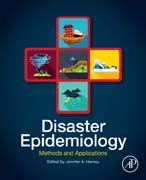
Disaster Epidemiology: Methods and Applications applies the core methods of epidemiological research and practice to assess the short- and long-term health effects of disasters. As we look to the challenge of building a more resilient future, we face an aging population who increasingly live in highly vulnerable coastal areas and large cities where the number and severity of large-scale natural disasters is increasing due to natural and technological disasters, climate change, and other natural and manmade stressors. This book provides a guide to disaster epidemiology methods, helping researchers, public health practitioners, and governmental policymakers quantify the impact of disaster on the health of individuals and communities. Further, the book explains how public health surveillance, rapid assessments, and epidemiologic studies can be conducted in the post-disaster setting to prevent injury, illness or death, how to provide accurate and timely information for decision makers, and what needs to be done to improve prevention and mitigation strategies for future disasters. These methods can also be applied to the study of other types of public health emergencies, such as outbreaks, emerging infectious diseases and refugee health. This book gives public health practitioner and researcher the tools they need to conduct epidemiological studies in a disaster setting and can also be used as a reference or as part of a course. Provides a holistic perspective to epidemiology with an integration of academic and practical approachesShowcases the use of hands-on techniques and principles to solve real-world problemsIncludes contributions from both established and emerging scholars in the field of disaster epidemiology INDICE: 1: History of Disaster Epidemiology; 1960s - 2015 2. Study Design: Present a brief overview of the basics of case-control, cohort, and cross-sectional study designs as typically used in epidemiology in general, and disaster epidemiology specifically. 3. Surveillance: Aaron Fleischauer Present a brief overview of public health surveillance and its application to disaster epidemiology (e.g., shelter surveillance, morbidity and mortality surveillance) 4. Questionnaire design and interviewing techniques 5. Community Assessment for Public Health Community Response (CASPER): David Zane, Tesfaye Bayleyegn Overview of CASPER method, examples of how it can be used to assess disaster impacts 6. Data analysis Chapters 7-12: Case Study Sections: Various Authors Six examples of the use of disaster epidemiology in response to both natural and technological disasters, including U.S. and international examples (possibly case studies from American Samoa and the Indian Ocean Tsunami). Chapter 13: Discussion and Conclusions
- ISBN: 978-0-12-809318-4
- Editorial: Academic Press
- Encuadernacion: Rústica
- Páginas: 200
- Fecha Publicación: 01/10/2017
- Nº Volúmenes: 1
- Idioma: Inglés
